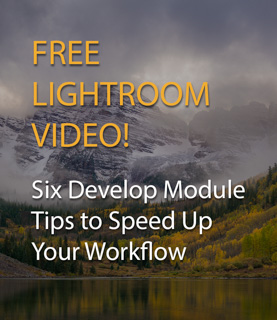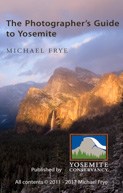In the Moment:
Michael Frye's Landscape Photography Blog
by Michael Frye | Jan 6, 2011 | Advanced Techniques, Digital Darkroom, Photography Tips, Video Tutorials
White Balance for Landscape Photographs – Part 3: A Special Problem from Michael Frye on Vimeo.
Here’s the third part of my video series on white balance, where I present solutions to a common problem in landscape photographs—finding the right white balance when mixing low-angle sunlight with blue sky.
If you haven’t seen them already, here are links to Part 1 and Part 2.
To see this video clearly, be sure that “HD” is on (the letters “HD” should be white instead of gray; if not, click on them), and click the “expand” icon just to the right of “HD.”
Hope you find this helpful; I look forward to hearing your comments! And if you like the video, please share the link.
by Michael Frye | Jan 4, 2011 | Announcements

Winter sunrise from Tunnel View, February 7th, 2010
Update, Friday, January 7th:
This afternoon I counted the votes and listed the top ten images in another post. I still welcome hearing about your picks—they just won’t count toward picking the top ten. Thanks for your participation everyone!
As I mentioned in my last entry, Dan Mitchell had a great idea: he posted about 50 of his best photographs from 2010, and asked his blog readers to help him pick out the best ones. Dan has some beautiful work, and you can see the final results here.
I liked this idea so much I thought I would, uh, borrow it—with Dan’s permission of course. So I’ve set up a page with 46 of my best images from 2010, and I’m asking for help in picking out the top ten. After you look through them you can post a comment with your favorites. Once I’ve narrowed it down I’ll post the top ten on this blog, and submit the finalists to Jim Goldstein’s blog project, where once again he’ll be showcasing the ten best images of the year from over 100 photographers.
The judging for the my final ten will be more like Dancing With the Stars than America Idol. That means that unlike Idol, where only the viewer’s votes count, the judge—me—gets a say too, so if one of my favorites gets panned by everyone else I may still include it. But as one of my photographer friends, Clinton Smith, once said, we don’t get to pick our best images—the world does. So your votes will carry a lot of weight.
So have at it! And thanks for your participation—I really appreciate your taking the time to give me your thoughts about these photographs. Here’s the link to those 46 images again.
by Michael Frye | Dec 31, 2010 | Announcements
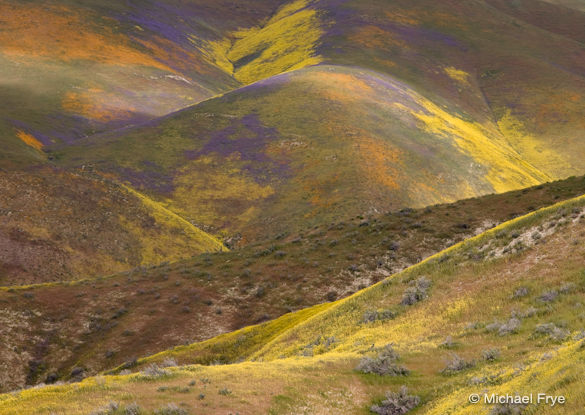
Wildflowers in the Temblor Range, April 3rd, 2010
Thanks to all of you for your participation in this blog during 2010. Your readership and comments have helped make this a great year. Your thoughts and insights about landscape photography have added great depth to whatever I’ve written here. I feel like I’ve made many new friends, and connected with lots of people who share a passion for landscape photography.
Among the regular commenters, three recently had work accepted into the Yosemite Renaissance XXVI exhibit: Robin Black, Brent Gilstrap, and David Hoffman. Congratulations! The exhibit opens February 25th at the Yosemite Museum Gallery. The opening reception is always a lot of fun, so I hope to see some of you there.
Another frequent contributor is fellow blogger G Dan Mitchell. Dan just did something really interesting. Attempting to pick out his best photos from 2010, he invited his readers to help him make the selections. He just posted the final results last night, and it’s a great collection of images.
Highlights From the Past Year
I thought it might be appropriate to look back at some of the highlights of the past year. This is not a comprehensive list by any means, so if your favorite post is missing, I apologize! These are just a few things that jumped out at me as I looked back through the posts from 2010.
Critiques
In January I did my first photo critique, of Tim Parkin’s photograph that he called “That Damned Loch.” The critiques have become very popular; you can find them all by clicking on the Critiques Category at the bottom of the right-hand sidebar. Meanwhile Tim has gone on to launch a new online magazine called Great British Landscapes. This looks like a great resource for any landscape photographer, British or otherwise, and I wish Tim much success with this venture.
Podcast Interview
Also in January, popular photo blogger Jim Goldstein recorded a podcast interview with me. Jim really has his pulse on the latest trends in the ever-changing world of digital photography, and I highly recommend reading his blog and following him on Twitter.
The One That Got Away
On March 1st I wrote a post about a fantastic sunset in Yosemite Valley that I missed. In April I critiqued a beautiful photograph by Sudheendra Kadri. Well it turns out that Sudhi also captured a fantastic image of that sunset from Tunnel View on that day when I decided (much to my regret) to stay home. Nice one Sudhi!
Temblor Range Wildflowers
In early April I photographed the most amazing wildflower display I’ve ever seen in southern California’s Temblor Range. I posted one photo on this blog, and more on my 25 Years in Yosemite blog.
First Video
June brought my first video tutorial, called The Power of Curves. Since then I’ve posted several more videos about the digital darkroom, and these have also become a popular feature on the blog. To see them all, scroll down to Categories at the bottom of the right-hand sidebar, and click on Video Tutorials.
Photographs That Inspire
One of the most popular and most re-tweeted posts from 2010 was called Photographs That Inspirefrom September 29th. This was a subject that I’d been thinking about for a long time, so it was great to see such a positive response—thanks!
What’s Ahead in 2011
I want to make this blog an even better resource for people who love landscape photography. I’m planning many new features in 2011, which I’ll announce… at the appropriate time. Stay tuned! And please invite your friends to join the conversation. The more ideas we share, the more we all learn.
Thanks again for helping to make 2010 a great year!
by Michael Frye | Dec 30, 2010 | Critiques
Light
This week’s photograph was made by Jeremy Long in Joshua Tree National Park, California. The image is an interesting study

of both composition and light. Of course it’s impossible to separate the two, as one always affects the other, but when analyzing a photograph it helps to consider each aspect on its own.
Warm, early-morning sunlight rakes across the scene from right to left, highlighting the rock obelisk and making it look three-dimensional. Most of the foreground juniper remains in the shade; a rock formation probably blocked the sun from hitting the tree. Initially I thought it might be better to see sunlight striking the juniper as well, but the shade sets up a nice contrast with the lighter background, focusing attention on the shape of the tree rather than it’s color and texture, and that emphasis on shape works well here.
The clouds add a nice touch. While I wouldn’t call this spectacular light, it’s very good, and perfectly appropriate for the subject.
Composition
The main feature of this photograph is the juxtaposition between the arching tree and the rock obelisk. The fact that this idea comes through so clearly demonstrates how well Jeremy composed the image. The design is clean and simple, and the main elements stand out clearly, with little extraneous clutter.
There are only two small things I can nitpick about the composition. First, I’d like to see a little more breathing room between the top of the rock and the juniper. Although they don’t actually merge, they come close, and putting a bit more space between these two elements would help the main idea stand out more clearly, and make the whole photograph feel more balanced. Just lowering the camera position a few inches would have accomplished this.
Second, the two main elements are in the center and left of center, with mostly empty space to the right. Perhaps Jeremy was trying to show more of the clouds, but to me those clouds, while nice, don’t carry the same weight as the rock and tree, and the image would feel more balanced if the camera were pointed slightly more to the left.
Technical Considerations
Jeremy captured this image with a Nikon D700 and 14-24 mm lens at 24 mm. The shutter speed was 1/10 sec. at f/22 and 200 ISO.
That small aperture helped keep everything in focus, and the photograph looks quite sharp. The exposure also looks perfect, with detail in the clouds and all but the darkest shadows. The overall contrast looks about right.
This kind of situation presents a difficult white balance problem. If you watched my first white balance video you’ll remember that I usually recommend color temperatures around 5000K to 5500K—daylight—for images with sunlight, like this one. Setting a higher color temperature makes an image more amber or yellow, which enhances warm tones in objects lit by low-angle sunlight, like the rocks in this photograph. But warming the image also adds yellow to the blue sky, and blue and yellow are opposites. Push the color temperature high enough and the sky will turn gray. Raising it even a little will make the sky muddy.
Jeremy told me that he set the color temperature to 6686K. This warm color balance made the rocks look great, but the blue sky has lost some of its vibrance. So I took this image into Photoshop and used a Selective Color adjustment layer to subtract yellow from just the blues. This helped purify the sky color and restore some of it’s natural brilliance. I also subtracted cyan from the yellows, making the rock obelisk a bit warmer. The differences are subtle, so I’ve included a side-by-side comparison.
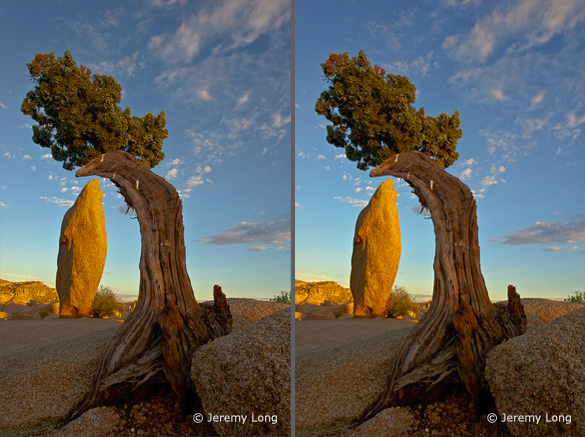
Left: the original image; Right: modified with Photoshop’s Selective Color tool
In my next, and last, video on white balance I’ll explain exactly how to use Photoshop’s Selective Color tool to get rich, warm tones on the landscape while keeping vivid blues in the sky.
Conclusions
This photograph has good light, a clean, simple composition, and is technically well executed. Overall it’s very well done.
What I’d say to Jeremy, and to anyone else who can compose and execute a photograph this well, is to try and take the next step, and make photographs that capture a mood, or somehow convey the feeling of what it was like to stand in a particular place at a particular time. The juxtaposition of the rock and tree in this photograph is interesting and eye-catching, but not particularly moving. And I know Jeremy is capable of capturing a great mood—here’s one example.
Your Comments
I’d love to hear your thoughts about this photograph. Do you agree that there should be more space between the tree and rock? What do you think about the sky color?
Thanks Jeremy for sharing your image! You can see more of his work on Flickr.
If you like these critiques, share them with a friend! Email this article, or click on one of the buttons below to post it on Facebook or Twitter.
As part of being chosen for this week’s critique Jeremy will receive a free 16×20 matted print courtesy of the folks at Aspen Creek Photo. If you’d like your images considered for future critiques, just upload them to the Flickr group I created for this purpose. If you’re not a Flickr member yet, joining is free and easy. You’ll have to read and accept the rules for the group before adding images, and please, no more than five photos per person per week. I’ll be posting the next critique in two weeks. Thanks for participating!
by Michael Frye | Dec 17, 2010 | Advanced Techniques, Photography Tips
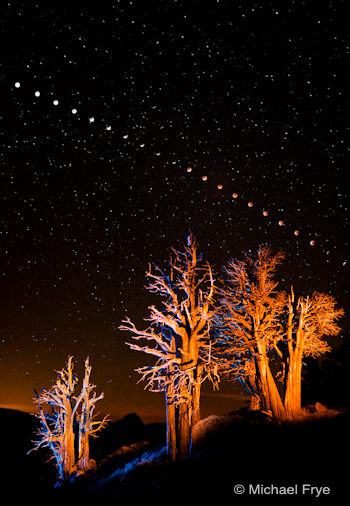
Lunar Eclipse Sequence, 1:23 a.m. to 4:49 a.m., August 28, 2007
Before getting to the topic at hand, I want to thank all of you for your support in launching my new eBook, Light & Land. The first day’s sales were amazing, off the charts, so thanks to all of you who bought a copy. And if you haven’t purchased it yet, there’s still time to get 20 percent off. See my last post for details.
So on to the eclipse… I was honored to have this lunar eclipse photo recently selected for the Natural World Exhibit at the Center for Fine Art Photography in Fort Collins Colorado. By coincidence, there will be another full lunar eclipse Monday Night—an opportunity to try making your own eclipse photograph.
Now here in California there are lots of dire weather forecasts for the next few days, with predictions of five to ten feet of snow above 7000 feet in the Sierra Nevada, and five to ten inches of rain in the foothills and Yosemite Valley. Minor flooding is possible. So there’s a good chance that we won’t see Monday night’s eclipse at all. But you never know—all it takes is a small break in the clouds. And those of you in other parts of the world may have perfect weather for this event. To see where and when the eclipse will be visible (weather permitting), visit the NASA web site. (more…)






